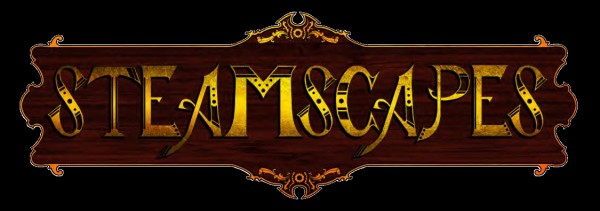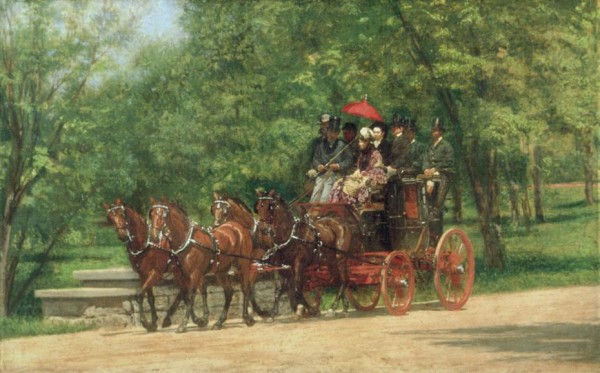Eric Simon, aka Fairman Rogers, is the Lead Developer for Steamscapes, a steampunk setting for the Savage Worlds role-playing game. He was kind enough to take the time to answer a few questions about the game for us.
How did you get involved with creating a steampunk setting for Savage Worlds?
My first thoughts about designing a steampunk setting emerged about five years ago, during a discussion on the drive back from Gen Con (a context that will be familiar to many budding game designers). At that time, the field was wide open, and I felt that steampunk was not being well-served in roleplaying games. Since then, the genre has exploded and there are a wealth of great settings and games – even other Savage Worlds settings – and I am definitely happy to see the variety of choices now available.
My initial plan was to design my own system, but it quickly became clear that trying to develop mechanics from scratch would make it much harder to focus on the historical background, which was my main passion. Savage Worlds was a clear fit very early on for several reasons: it has a pulpy, adventurous flavor, it is very easy to tweak and customize, and its licensing arrangement is very well-suited to new publishers. Since becoming a licensee, I have also found that the community of players and publishers for Savage Worlds is incredibly supportive, so that has been a wonderful bonus.
How does Steamscapes: North America diverge from our history books?
Our diversion point takes place in 1768, when Lord Chatham, William Pitt the Elder is developing the Anglo-Prussian alliance. In real history, he failed and resigned as Prime Minister, leaving the office to Lord North, who was much more hostile to the American colonies. By keeping Chatham in office through the independence crisis, I was able to develop an explanation for avoiding the American Revolution. The Atlantic colonies are granted commonwealth status, keeping them as part of the British Empire for much longer, but as a result drastically changing the face of North American politics. The colonies become a land of both economic and technological opportunity, thus explaining the acceleration towards steampunk, but France, Spain, Texas, and Mexico have very different interactions with a more British America, leading to a North America in 1871 (the “now” of our setting) that is quite fragmented.
Obviously, there is much more detail covering the intervening hundred years, and I could go on for a very long time. But I will leave that as a rough overview.
How does Steamscapes: Asia dovetail with the North American world?
I have tried to make the history of the rest of the world follow directly from the implications of that one shift. In Asia, the cascade begins with India. Because of the opportunities available in North America, there are fewer compelling reasons during the late 1700s and early 1800s for British middle class families to move to India and work for the East India Company. In addition, the sustained conflict with France (which I imply at various points is much stronger in the Steamscapes timeline) keeps many of the top British military leaders in Europe, making it harder for the Company to recruit good personnel. This allows the Sikh Empire to win its war against the East India Company, and then for the 1857 rebellions to result in independence for the various kingdoms of India and the eventual complete removal of the East India Company. This drastically changes the interactions that other countries have with England and other colonial powers – China wins the Second Opium War, Japan allies with England, Burma and The Philippines both win their independence, and so on.
Asia is a more complicated web of consequences than North America, largely because there are so many more countries involved. However, I am making a special effort to make it as clear as possible, even to readers unfamiliar with the general history of these countries. Asia will be a significantly larger book than North America because we are giving so many different countries their own writeup. I hope that this effectively presents the diversity of stories and settings available on the continent.
In your Dev Notes, you correlate the steampunk “sexy corset” with fantasy “bikini armor.” As a game developer, what to you do to provide women with practical characteristics (ie not wearing underwear on the outside)?
Much of that certainly comes through in the art. Simply offering realistic historical depictions of women can go a long way. We work with artists who have similar goals, and we choose historical photographs of women (like Belle Starr and Stagecoach Mary Fields) who are presented in accurate period clothing. I am always careful to say that the “sexy corset” style of costuming is not inherently wrong because there is no badwrongfun, especially in steampunk. However, we wanted to offer a different choice that reflected the realistic alt-history aesthetic of the Steamscapes setting.
Within the game rules and background, we are careful to present women in all of the character roles (you’ll see female Aviators and Steamhands in the art for Asia), and in Asia in particular it has become more possible to bring in key female historical figures and even make some of them the leaders of their respective countries, like Rani Lakshmibai. One of the goals in Steamscapes has always been to highlight what I refer to as “lost” history – those amazing moments and individuals that we don’t hear about it in school but that show us that history is not as white or as male as we think. The recent surge in interest about Bass Reeves has pleased me to no end.
There appears to be a heavy corporate backdrop to the events in Steamscapes: North America. How does this comment on the contemporary political sphere?
I grew up in the 80s, so I have a strong attachment to the cyberpunk sense of corporate dystopia. I believe there is an opportunity in steampunk for this kind of commentary as well, especially when we look at the kind of corporate control that existed in the 19th century. That was the age of monopolies, company towns, and debtor’s prisons. The East India Company conquered an entire region and acted as an independent political entity with its own military. We certainly do not see anything quite on that level these days, but that era of excess can serve as a caution for what could happen again. My steampunk is as as much Dickens as it is Jules Verne.
Bonus question: How does your Fairman Rogers steamsona (steampunk persona) interact with the Steamscapes world?
With my strong interest in history, I wanted my steamsona to be based on a real historical figure. Fairman Rogers was a professor of civil engineering at the University of Pennsylvania, and he was very much a model of a Victorian thinker – diverse in his interests and pushing technology forward in a variety of ways. As the steamsona Fairman Rogers, I see myself as a professor, always observing and commenting. I am offering the recent political and technological history of the world so that you may understand it better. Also, the Thomas Eakins painting, “The Fairman Rogers Four-in-Hand” (which shows Rogers driving a coach), is the source for my company’s name and logo. I like to include little nods like that in everything I do.
Steamscapes is availabe through Studio 2 publishing at http://studio2publishing.com/search?q=steamscapes.



There are no voices yet... Post-script us a message below, won't you?